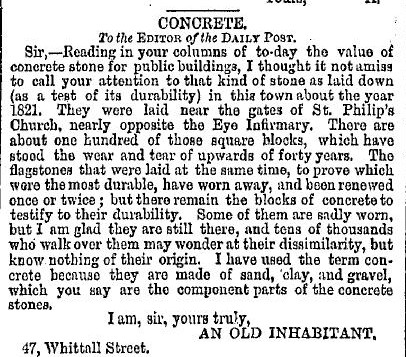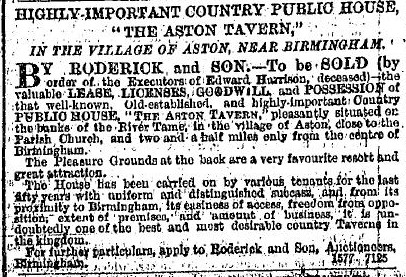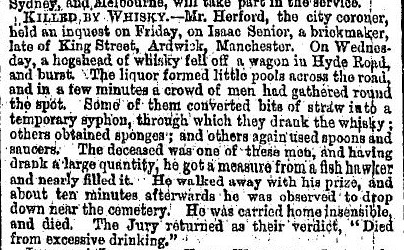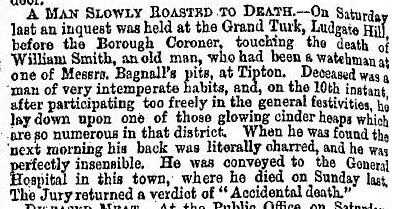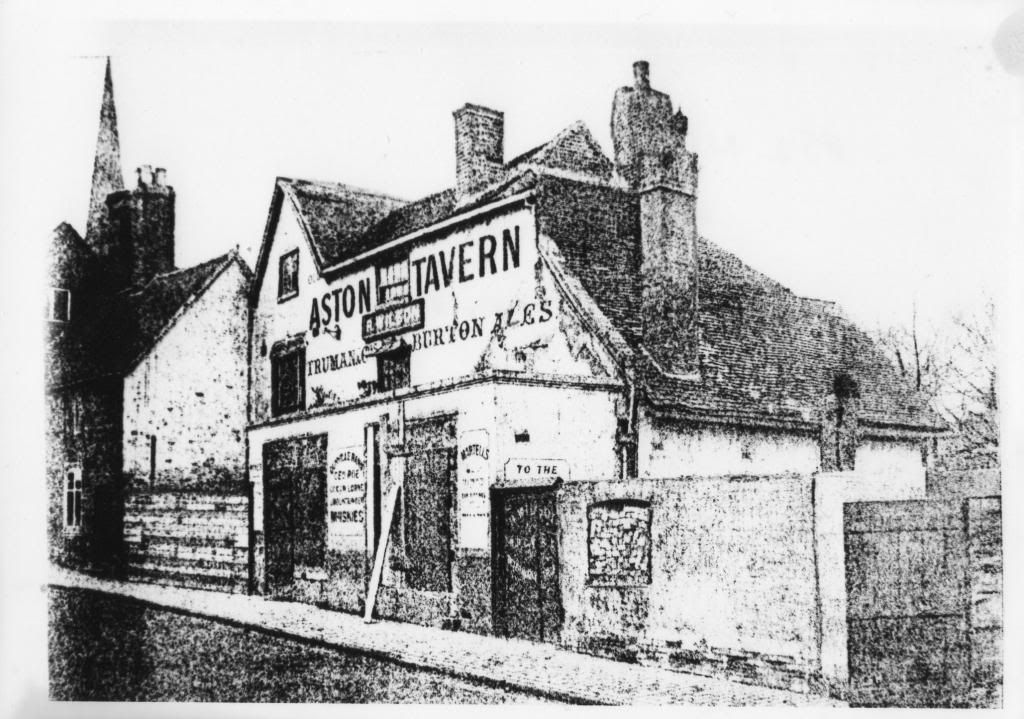-
Welcome to this forum . We are a worldwide group with a common interest in Birmingham and its history. While here, please follow a few simple rules. We ask that you respect other members, thank those who have helped you and please keep your contributions on-topic with the thread.
We do hope you enjoy your visit. BHF Admin Team
You are using an out of date browser. It may not display this or other websites correctly.
You should upgrade or use an alternative browser.
You should upgrade or use an alternative browser.
Newspapers : From Birmingham Post 150 years ago
- Thread starter mikejee
- Start date
19.3.1863
I put this in as it is in Villa St, of interest to Lyn, but in the same issue there are three other similar notices, all for 28th Feb. of similar religious buildings no longer registered. If others are of interest to anyone i can post them also.
View of the illumination of St Phillips. Very good, but enough is enough!
Rather peculiar invitation. Mr Simons is the landlord/owner/occupant of the Kings Head hotel
Wives were still sold then. This was before thomas Hardy wrote the Mayor of Xasterbridge, but the Merthyr wife was a bit cheaper.
Have come across similar use of "interesting" previously. I assume the word had a somewhat different meaning then
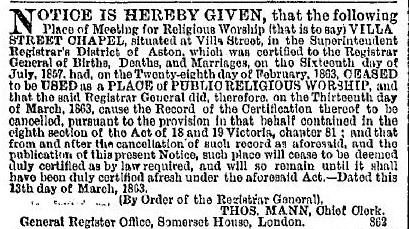
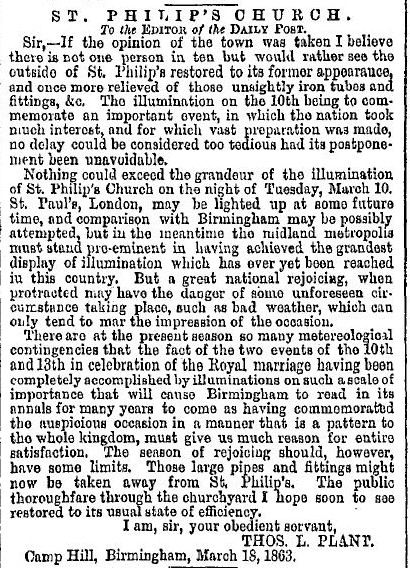
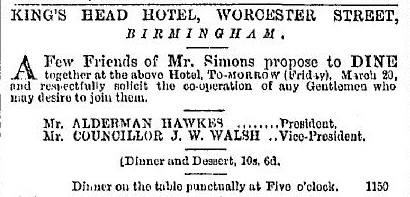

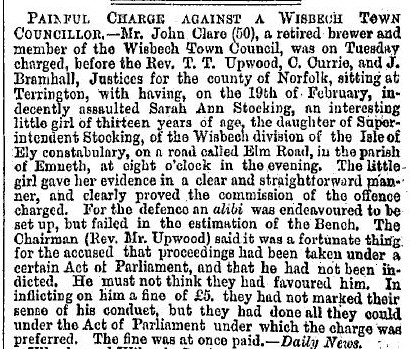
I put this in as it is in Villa St, of interest to Lyn, but in the same issue there are three other similar notices, all for 28th Feb. of similar religious buildings no longer registered. If others are of interest to anyone i can post them also.
View of the illumination of St Phillips. Very good, but enough is enough!
Rather peculiar invitation. Mr Simons is the landlord/owner/occupant of the Kings Head hotel
Wives were still sold then. This was before thomas Hardy wrote the Mayor of Xasterbridge, but the Merthyr wife was a bit cheaper.
Have come across similar use of "interesting" previously. I assume the word had a somewhat different meaning then





Had assumed various major churches were illuminated, not just St. Phillip's. A Birmingham 'first' for the record books. On first reading about the wife seller my immediate reaction was how disgraceful. But the last sentence makes me think she was well rid of him! In fact it sounds like it was organised. Viv.
paul stacey
master brummie
I am pleased to see that "Offical 'gobbeldy gook' language, #1/692, was in use in the mid 19thC, as well as to-day, who can make head nor tail of that short printed nonesense, is a better man than me. I also wonder what type of illumination, (Lamps), were used at St Phillips. I assume that the medium was "gas", but how it was conveyed or distributed, and what type of beams used is a wonder, the massive lengths of piping required would be phynominal. I also believe that in some parts of the country, wife selling was rife.!!
paul
paul
DavidGrain
master brummie
In 1863 divorce would have been very expensive and probably required a private act of parliament. Selling a wife may not have been legal but in the public mind was thought to be a legitmate way of dealing with a break down of a marriage. Almost certainly this was an arranged sale agreed between the parties. It was also done openly often in the market so that everyone could be aware that the parties had done this voluntarily.
Lyn
wondered if it was a previous chapel on the site of St saviours. Have sent you some cuttings
Mike
yes thank you mike ive got them and i have to agree on your theory
thanks mike..
lyn
21.3.1863
Part of minutes of meeting of General hospital committee on a proposed convalescent home in Sparkhill. Apparently domestic servants are particularly excluded from being treated.
A window in Worcester cathedral by the Birmingham craftsmen of Hardiman has been installed.
This report possibly fits in with the large number of prosecutions for condemned meat at the time. The producers often care nothing about their animals or their customers
I suppose this is one way to cut police costs
The Pope at the time, Pius IX, seems to have invented a lot of the dogma of the Catholic church, including that the Pope is infallable, so perhaps this sort of shenanigans is not unexpected.
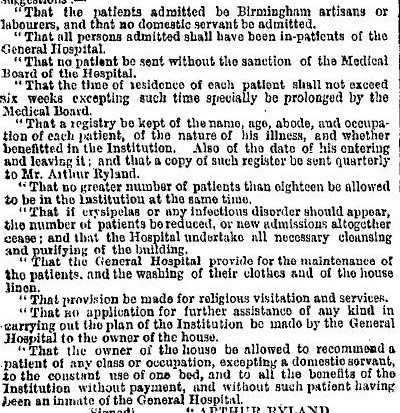
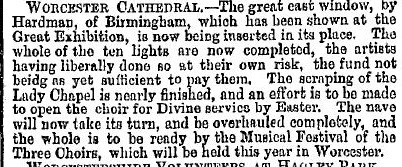
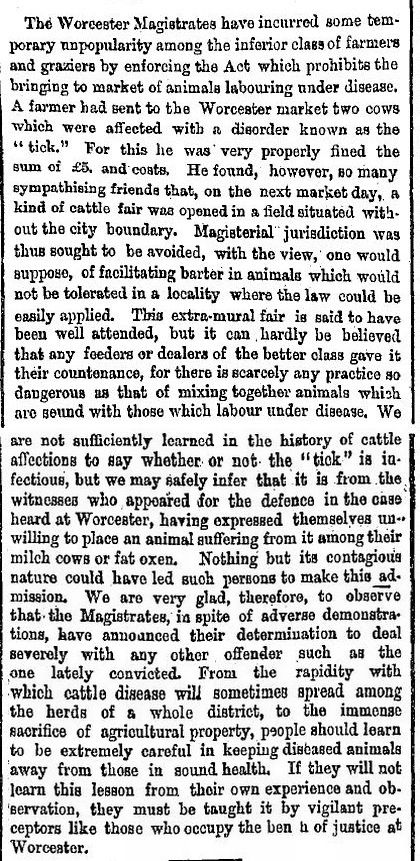
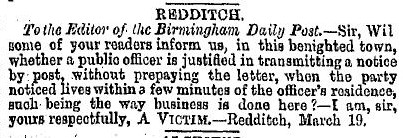

Part of minutes of meeting of General hospital committee on a proposed convalescent home in Sparkhill. Apparently domestic servants are particularly excluded from being treated.
A window in Worcester cathedral by the Birmingham craftsmen of Hardiman has been installed.
This report possibly fits in with the large number of prosecutions for condemned meat at the time. The producers often care nothing about their animals or their customers
I suppose this is one way to cut police costs
The Pope at the time, Pius IX, seems to have invented a lot of the dogma of the Catholic church, including that the Pope is infallable, so perhaps this sort of shenanigans is not unexpected.





Great picture Lyn! Sounds delightful too; on the banks of the Tame, pleasure gardens, close to the church etc. The sort of place you'd cycle to for an excursion. Lovely. Viv.
paul stacey
master brummie
seems incredible for Aston to be considered a Village, with a country Pub.!!
paul
paul
paul stacey
master brummie
I must say Viv, you do put some lovely photo's up on thread, this particu;lar on#705, really brings out the beautiful, clean, Birmingham from my childhood, very atmospheric even with the powerstation in view, "by the way was that the 'Saltly' power station ??
regards paul
regards paul
Paul thank goodness we have the lovely photographic records like Keith Berry's to draw upon. Didn't he and Phyllis Nicklin do a superb job of capturing Birmingham on the cusp of major change in the 1960s? So at least we have a good record of these places, even if they've now changed beyond recognition. Viv.
paul stacey
master brummie
I have to admit Viv, that I do not know the people you have mentioned, but,'hey', that's what this forum is all about, "learning", but as you say, thank goodness for these far thinking individuals!!, I left Birmingham in 1962, and on my brief visits home realised even at that young age, that we were losing something precious, and that the changes were vast and for ever.
paul
paul
I wouldn't have known about the photographers either Paul if it hadn't been for this site! Yes, it's a good place to learn new things. Viv.
24.3.1863
This is the first evidence that the new volunteer fire brigade , unattached to, and disliked by, insurance companies is now in existence
Apparently previously anyone could sell alcohol & tobacco at fairs and races, without being licensed.
I am not sure where this Weslyan church is. Certainly there is no Weslyan church in Islington (the street, now part of Broad St), but Islington is also used to denote an area, but still cannot identify it.
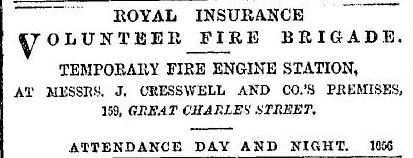
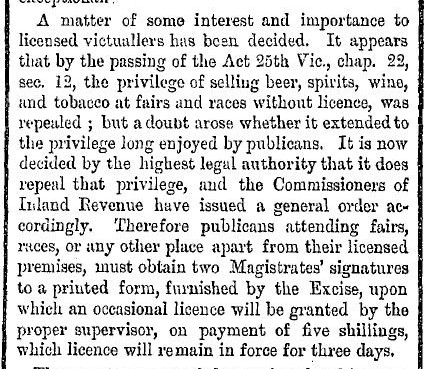
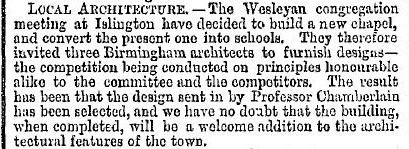
This is the first evidence that the new volunteer fire brigade , unattached to, and disliked by, insurance companies is now in existence
Apparently previously anyone could sell alcohol & tobacco at fairs and races, without being licensed.
I am not sure where this Weslyan church is. Certainly there is no Weslyan church in Islington (the street, now part of Broad St), but Islington is also used to denote an area, but still cannot identify it.



25.3.1863
Fire in Holt St
Never heard of Round hills Aston. Was it an area of Aston?
Sydenham College is listed in the directory as Sydenham College Medical School, presumably associated with the General Hospital.
Did they have special open areas to hold wakes in ?
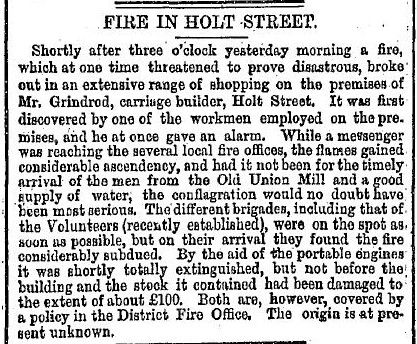



Fire in Holt St
Never heard of Round hills Aston. Was it an area of Aston?
Sydenham College is listed in the directory as Sydenham College Medical School, presumably associated with the General Hospital.
Did they have special open areas to hold wakes in ?




Lyn
As I said, I didn't remember hearing of it before, but can find it mentioned in directpries up to 1862. It was in aston manor. Am having some problems confirming thid definitely, but am coming to the conclusion that it was an old name for aston road north. this seems to appear as round hills disappears, and apparently Park lane, park crescent,pool st and yates st all joined it
As I said, I didn't remember hearing of it before, but can find it mentioned in directpries up to 1862. It was in aston manor. Am having some problems confirming thid definitely, but am coming to the conclusion that it was an old name for aston road north. this seems to appear as round hills disappears, and apparently Park lane, park crescent,pool st and yates st all joined it
paul stacey
master brummie
I take it that the advert, #2/711, refering to a rent of £18, was "per annum" not weekly/monthly. ??
paul
paul
thansk mike and dottie...i have never heard of round hill...just wondering if if was near to park lane aston...
lyn
Morning Lyn. Never heard of Round Hill either. Looked it up and Bill Dargue has written this about Round Hill(s):
"The area between what is now New Town Row and Aston Road was known as (The) Round Hill/s. Its first mention is probably when the land was sold as an estate in 1596 by Sir Thomas Holte to Roger Pemberton, a Birmingham goldsmith. In a deed of 1795. Near Round Hill and Far Round Hill are referred to, so-named presumably with reference to Aston Hall.
Round Hill later seems to have been used as the name of the hamlet and may have been a streetname, possibly the lower end of Sutton Street, until the mid-19th century. The 1841 census lists some 30 dwellings and a population of about 150 of whom over half were born outside Warwickshire. There was a surprising diversity of occupations and of wealth here. People were involved in a variety of working-class jobs such as washerwomen, metal workers, workers in the gun trade, bricklayers, a sawyer and a saddler . There were 17 servants living here, some apparently in boarding houses, but eight of the households had their own servants living in. Middle class occupations included an attorney, an iron founder, an engineer, an engraver and a cheese factor. There were a number of residents with servants who were living on independent means.
By 1891 the name existed only as a house name, Round Hill Cottage in Cheshire Street. That street is now gone, but it lay just north of Pool Street.
There appear to have been two Round Hills. The other is a little to the south of the former, lying between Miller Street and Brewery street. It is shown on Blood's map of 1857. Land here belonging to the Keirle family is recorded in 1590".
Viv
MichaelPatrick
New Member
Hi,Mike, Ive tried to find Birmingham Post archives with no success...can you help me out?
pollypops
master brummie
Hello Michaelpatrick welcome to the forum. As far as I know there are two ways to access the Birmingham Post archives on-line - a subscription site
https://www.britishnewspaperarchive.co.uk/ where you can purchase a 2 day, 7 day, 30 day or 1 year package.
Or being a member of a library (Birmingham is one of them) that offers access to the 1800 to 1900 British papers for free - which I realise is not much use to you in Spain.
It there is something in particular you are looking for in the years 1800 to 1900 you could start a new thread and someone with access to the papers will look for you.
https://www.britishnewspaperarchive.co.uk/ where you can purchase a 2 day, 7 day, 30 day or 1 year package.
Or being a member of a library (Birmingham is one of them) that offers access to the 1800 to 1900 British papers for free - which I realise is not much use to you in Spain.
It there is something in particular you are looking for in the years 1800 to 1900 you could start a new thread and someone with access to the papers will look for you.

